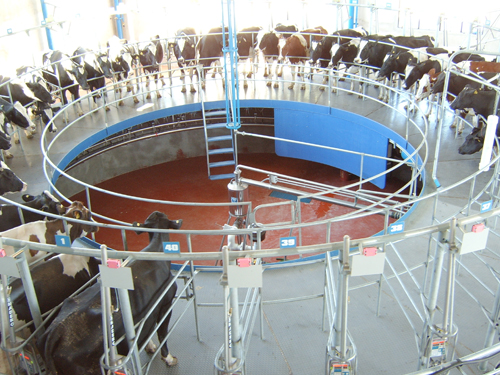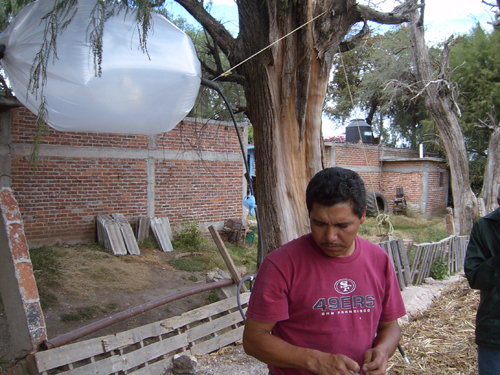

Twenty-three wind powered generators, each 160 feet high, stand in the fields of Wigton, 2,300 feet above sea level. Each turbine is equipped with enormous blades more than 170 feet in diameter. The turbines convert the kinetic energy of air currents—wind—into electricity. Temperature and pressure changes produced in the atmosphere by the absorption of the sun’s rays make the air move naturally from high pressure areas to low pressure areas, and this air movement creates wind. This process is particularly notable in the Caribbean, where the “trade winds” blow frequently and powerfully.
With an installed capacity of 20.7 megawatts and connected to the country’s electric grid, the Wigton Wind Farm is the largest in the Caribbean. In fact, the power it generates is enough to supply more than 25,000 households per year. To build it, the Jamaica Petroleum Corporation hired workers and young engineers from the area and trained them in wind energy technologies and substation management. In addition to the benefits of local jobs and clean electricity generated from domestic rather than imported fuels, the project supports a series of local economic and social activities, including support for the nearby rural school.
The Wigton Wind Farm has become an important model for other countries looking to convert wind into essential renewable energy by using the latest technologies. But this modern and innovative project is based on an age-old idea. In fact, humans have been harnessing the power of the wind to generate energy for thousands of years. Sails that used wind power to move boats were the first example. Later, rudimentary wind mills were built in Persia between the sixth and tenth centuries. These vertical axis machines were used to mill grain and pump water. Variations of this technology were created throughout the centuries until the advent of electricity.
To meet today’s needs, however, the traditional wind mill has been redesigned, marrying aerospace and computer technologies to open a whole new generation of wind technologies. Modern wind mills can produce enough electricity to supply individual households or they can be multi-megawatt machines connected to large power grids.
Wind farms are now operating in more than 65 countries worldwide. In Latin America, the countries of Mexico, Costa Rica, Brazil, Argentina, and Ecuador are utilizing this valuable resource, along with other renewable energy sources, to help meet their energy needs.
Why is there now a growing emphasis on the use of renewable natural resources for energy generation? For Jamaica, the answer is clear. Wind does not generate local pollution or result in emissions that cause climate change. Wind is a local resource, so there is less need to import fuels. Finally, once the investment is made in a wind power plant, there is a reduced cost for fuel; so the price of power does not fluctuate drastically. These and other advantages are very attractive for a country whose energy generation otherwise depends almost exclusively on imported oil, and whose inhabitants pay more than 25 cents per kilowatt hour of electricity, more than four times what some energy users in the United States pay for the same service.
Modern renewable energy involves various kinds of power generation and fuel conversion processes that use inexhaustible or naturally reproduced resources as fuel. Enormous technological developments during the last 30 years have resulted in huge improvements in the efficiency of these technologies and dramatic reductions in their costs. For example, the average cost of electricity generated at a 20 megawatt wind farm has fallen by over 25 percent in the past eight years. As a result, we are seeing an increase in the use of wind energy and expanding options available to customers. During the same period of time, the use of wind energy increased seven-fold around the world, from 10 gigawatts installed capacity to over 71 gigawatts.
In addition to wind energy, other renewables are currently being deployed on a commercial basis in the Americas, including solar, biomass, hydro, and geothermal power. Many people are familiar with solar energy in the form of solar hot water heaters and solar photovoltaic (PV) panels that generate electricity. Getting electricity into remote rural communities continues to be a major challenge for much of Latin America, where some 50 million people still lack access to power. PV panels offer a solution in areas where extending the power grid is difficult and cost prohibitive. Panels may be placed on roofs or poles for homes, schools, clinics, and churches. These dispersed approaches to electrification offer cost-effective solutions for countries working to improve the infrastructure in rural and indigenous communities. For example, Brazil plans to provide electricity to 2.5 million households by 2008 as part of its Luz para Todos (“Light for Everyone”) program. About 700,000 households have already been connected to an electricity source. However, many citizens live in very small communities, far away from the nearest power lines. Thus, the government has targeted over 200,000 households— about ten percent of the total—to be served with off-grid solar power. Once communities have electricity, they use the power as an instrument for social and economic development that reduces poverty and increases income.
While photovoltaic cells produce electricity directly from sunlight, solar hot water panels draw on the heat from the sun to produce hot water. Such systems are extremely effective in reducing energy demand and can pay for themselves in less than five years in areas where conditions are appropriate. Barbados recognized this opportunity in the 1970s when the government implemented its tax incentive program for solar hot water heaters. As a result of this commitment, Barbados has become a global leader in the production of solar hot water heaters, and it is estimated that over 40,000 household and hotel-based systems are in use on the island today. The combined effect of these systems results in the reduction of electricity demand. In fact, it is estimated that solar power has decreased the country’s electricity consumption by more than 15 percent.
Hydropower systems typically provide electricity to central power grids, but they may also be configured for small scale community systems or to produce mechanical energy. Hydropower is created by channeling water downhill to turn a turbine connected to a power generator. Hydropower is among the most important sources of electricity for many countries in the Americas, accounting for approximately 75 percent of the electricity in Peru, 35 percent in Chile, 73 percent in Panama, and 10 percent in the United States. Brazil is one of the largest consumers of hydropower in the world, and 90 percent of its power needs are supplied from this source.

When the Chel initiative was launched in 2001, people from the three villages formed the Chalense Hydroelectric Association (AHCH) with the support of a Guatemalan non-governmental organization called the Solar Foundation. Each family that is a member of the project contributed 80 days of labor to build the local network and the home installations. When construction began, 572 village residents began to work on the construction of the civil works projects. Working by hand, the communities built a road that crosses the mountains to transport the electro- mechanic equipment that is part of the power plant.
“Even before the project began, when not even a single kilowatt of electricity had been produced, AHCH had already begun to receive income from the energy that was going to be generated in the future,” said Marta Rivera, vice-president of the Solar Foundation Board of Directors. “AHCH also assisted Hydro-Xarbal, a hydroelectric company with an installed capacity of 94 megawatts, in its negotiations with local indigenous communities to create a right of way for the transmission lines. The early payments helped cover aspects of the construction in the final phase of the project.” “The people of Chel have such a sense of ownership over the process that children have begun to play at building hydroelectric dams instead of playing war games,” says Rivera.
Biomass—organic material such as wood and wood by-products, agricultural by-products, municipal waste, and animal waste—is the oldest source of energy known to mankind. For thousands of years, people have burned wood to generate heat and cook food. Even today, the traditional combustion of wood or dung is one of the most important sources of energy in the world. But its use is not considered sustainable from an environmental, health, or economic standpoint.

In the Mexican state of Guanajuato, the local government and the Science and Technology Council (CONCYTEG) have developed a biofuel project oriented to small livestock producers. The project provides training in the use of bio-digesters to transform animal waste into methane gas. The bio-digester is a sealed tank where animal manure is mixed with water and fermented to produce methane. What is left over is used as fertilizer.
“The project is being implemented in rural communities with families that have at least two or three head of cattle and produce between 110 and 155 pounds of pig or goat manure every day,” says Dr. Ernesto Camarena from the Institute of Agricultural Sciences at the University of Guanajuato. “With this technology, it has been possible to practically replace the consumption of firewood and liquefied petroleum gas, fuels that have traditionally been used to meet energy needs for food preparation or heating bath water. This helps the economic situation of people in this social group.”
 Thirty-seven year old Erasmo García Muñoz, a resident of the Hacienda de Márquez community, is very interested in using the bio-digester. García Muñoz, who lives with his mother, wife, and three children, raises cattle for a living and says the bio-digester has notably improved the quality of life for him and his family. “I was going to have to migrate north to get work to support my family. Now with the animals, and with what we save on gas, we can get by. We don’t buy gas anymore, because we don’t have any use for it anymore.”
Thirty-seven year old Erasmo García Muñoz, a resident of the Hacienda de Márquez community, is very interested in using the bio-digester. García Muñoz, who lives with his mother, wife, and three children, raises cattle for a living and says the bio-digester has notably improved the quality of life for him and his family. “I was going to have to migrate north to get work to support my family. Now with the animals, and with what we save on gas, we can get by. We don’t buy gas anymore, because we don’t have any use for it anymore.”
Depending on gasoline and diesel fuels has significant downsides, given rising petroleum prices, fuel supply insecurity, and local and global environmental impacts. These concerns have led to a significant increase in interest in ethanol and biodiesel fuels. In the United States, ethanol production doubled in 2006. In Brazil, ethanol currently accounts for about half of all transport fuel. The cost for Brazilian ethanol, produced largely from sugarcane, has fallen to less than US$35 a barrel. The recent push to biofuels has generated new concerns regarding the trade-offs involved in using land for energy or for food products, along with other socio- economic challenges. However, existing commitments like the US 20/10 goal—to reduce gasoline consumption by 20 percent in ten years—are expected to lead to exponential growth in interest in biofuels. Expected technical breakthroughs in the area of cellulosic ethanol would allow certain grasses and agricultural refuse to be used to produce ethanol. This would hopefully mitigate concerns regarding land use and rising costs. On March 9, 2007, US President George Bush and Brazilian President Luiz Inácio Lula acknowledged this growth when they signed an agreement in Brazil calling for both countries to “support biomass energy generating development in South America, Central America, and in the Caribbean and Africa.”
Geothermal heat from the earth can also be harnessed as a source of renewable energy; it can be converted into electricity or used directly for heating. In the Americas, geothermal power is most commonly produced by power plants that convert high temperature steam (300-650ºF) into electricity. Geothermal power is currently produced in 20 countries of the world at prices that are competitive with traditional forms of electricity generation. Volcanic areas of the Americas, including the Pacific Rim through North, Central, and South America and the Caribbean, offer great potential for the development and use of geothermal energy. In fact, the United States, Mexico, El Salvador, Costa Rica, and Nicaragua are considered world leaders in the use of this resource. Mexico began producing geothermal power in 1959 and currently generates nearly 1,000 megawatts from this resource. Geothermal makes an important contribution to power supplies throughout Central America, delivering over 15 percent of the total electricity in Costa Rica and 22 percent in El Salvador.
In Nicaragua, the 66 megawatt San Jacinto-Tizate Geothermal Project is not only generating reliable base-load power for consumers, but is also producing carbon credits that return additional value to the operation. The fact that geothermal power and other renewable energy sources do not produce greenhouse gases makes it possible for projects using these sources to earn credits for carbon trading through the Kyoto Protocol’s Clean Development Mechanism (CDM). The CDM enables wealthier industrialized countries to meet some of their obligations under the Kyoto Protocol by implementing projects to limit emissions in developing countries, thus off-setting the carbon emissions that occur under a “business-as-usual” scenario. Other renewable energy projects in the region, including the Wigton Wind Farm in Jamaica and El Guanillo Wind Farm in the Dominican Republic have also taken advantage of the various climate change mechanisms. The financial contributions from the carbon sales may be the equivalent of as much as 10 percent of the total cost of the renewable energy produced, and this translates into additional benefits for the local consumer. As the global community moves to less carbon-intensive energy sources, new opportunities in carbon markets are expected to grow from a US$29 billion market in 2006 to over US$31 billion in 2007. Renewable energy is ideally positioned to reap the multiple benefits that are emerging.
The production of sustainable energy is becoming more reliable, environmentally friendly, and cost effective, but its supply depends on a diversity of energy resources and proven technologies. No single source—renewable, fossil, or nuclear—will address all of the challenges. The environment, energy security, cost-effectiveness, and local job creation are among the many reasons why countries are seeking to increase their use of domestically sourced energy resources, including renewables. While it is true that no one can forecast exactly when fossil fuel reserves will run out on the planet, they will one day run out. Renewable energy—which before the use of
fossil fuels was the only energy source used by human beings for more than 5,000 years-is now back to stay.
Mark Lambrides is the Energy and Climate Change Division Chief at the OAS Department of Sustainable Development. Juan Cruz Monticelli is a lawyer and Senior Energy Specialist at the OAS Department of Sustainable Development.
This article was published in Américas magazine, a bimonthly publication of the General Secretariat of the Organization of American States, in June 2007.
 View Map
View Map